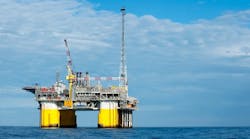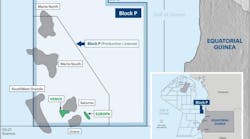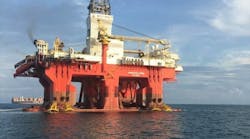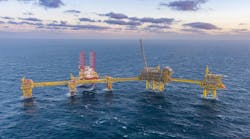David Paganie • Houston
DOT presents new floating platform designs
PennWell’s Deep Offshore Technology International Conference & Exhibition (DOT) is an event where operators, equipment manufacturers, contactors, and service-providers introduce new deepwater technology. This past February in Houston, the tradition continued.
INTECSEA/Worley Parsons Group used DOT to launch a new semisubmersible deepwater platform concept, the Damper Chamber Platform Semi (DCC Semi), for wet or dry tree applications.
The platform design is similar to a conventional semisubmersible with a ring pontoon and four columns supporting a topsides load, the company explained. But with the DCC Semi, the columns are configured with free-flooding inner chambers.
During quayside integration and the subsequent wet-tow to the installation location, the configurations of the columns and their large-diameter bottom sections provide substantial displacement and water plane area for stability. Unlike conventional semis, the volume of the pontoons and the column spacing is not determined by the pre-service conditions, and can be optimized to improve the platform’s response for in-service operations.
This arrangement, the company said, avoids unnecessary displacement in the column simply to control the column-pontoon ratio, a normal requirement under pre-service conditions. Consequently, displacement with the DCC Semi can be reduced compared with conventional semi designs. Also, the column spacing based on in-service conditions helps reduces deck steel requirements.
The inner chambers are flooded naturally at a draft deeper than both the quayside and wet-tow drafts. Once flooded, water inside the inner chambers provides “free” added mass that suppresses the semi’s motions, especially heave, by increasing the heave natural period at the in-place draft. It also helps optimize the column-pontoon volumetric ratio, an important factor in reducing the platform heave response.
The columns are constructed using a group of small-diameter cylinders. A skirt fitted at the lower end of the columns increases viscous damping through the vortex shedding at the skirt’s edge.
In a presentation prepared for DOT, the authors compared a DCC Semi with a conventional semi for a deepwater (1,830 m, or 6,003 ft) wet-tree application in the Gulf of Mexico. The DCC Semi in this case has been designed to support a total payload of 17,000 metric tons (18,739 tons), comprising 10,200 metric tons (11,243 tons) for the topsides and 6,800 metric tons (7,495 tons) for the 24 steel catenary risers (SCRs) and eight umbilical lines.
According to the comparisons, both designs provide a heave natural period of around 20 seconds, which is typical for GoM semisubmersibles. However, the DCC Semi’s displacement is around 30% less than that needed by the conventional semi to support the same payload. Also, the estimated steel requirement for the DCC Semi’s hull is 33% lower. The skirt appears to provide increased heave damping to reduce resonant responses, important in extreme sea states.
As for the dry tree version, the presentation illustrated the results of a DCC Semi in 2,438 m (8,000 ft) water depth supporting a total payload of 29,030 metric tons (32,000 tons). This is divided into 12,700 metric tons (14,000 tons) for the topsides, 4,536 metric tons (5,000 tons) for the drilling rig, 15 top-tensioned risers with a payload of 7,258 metric tons (8,000 tons), and 16 SCRs with a payload of 4,536 metric tons (5,000 tons). The design assumes a nominal tensioner stiffness of 219 kn/m (15 kips/ft).
The favorable features of the DCC Semi in this application, the company concluded, are a fairly small wave frequency motion response, especially in the heave direction in a harsh environment, and a high payload/hull steel efficiency. The design stroke appears to be within the existing stroke limit of the RAM-type tensioner, rendering the DCC Semi suitable for dry tree applications.
Closed centerwell truss spar explained
Technip’s Anil Sablok and Wade Mallard gave the attendees at DOT a presentation on a new truss spar configuration called the “closed centerwell (CCW) spar.”
The truss spar has been developed to reduce hull diameter and weight over the conventional open centerwell (OCW) truss spar for the same payload, without sacrificing the exceptional motion characteristics of the spar, the presenters explained.
The key to these enhancements, they said, is that, by closing in the hard tank section of the centerwell, the CCW spar generates additional buoyancy while retaining the functionality of the centerwell. This increased buoyancy supports greater topside, riser, and mooring payloads for a given hull diameter and length. Significant hull weight savings can be achieved relative to a conventional truss spar.
The smaller CCW spar hull is more flexibile in terms of fabricating and transporting the hull in one piece using existing fabrication facilities and transport vessels. Similarly, the reduction in CCW spar hull diameter facilitates lifting heavier topsides in one piece or larger modules, by allowing the heavy-lift vessel to be positioned closer to the centerline of the hull. The reduction in the size also reduces environmental loads on the hull permitting smaller mooring considerations. The CCW spar benefits further from incorporation of an improved compressed air ballasting system with higher variable ballast capacity from additional ballast tanks that can better accommodate the platform variable payloads that accompany retrofitting of risers and production equipment upgrades.
The presentation included a description of the truss spar closed centerwell concept and compared it to the existing open centerwell designs. Model test results were compared to those from an existing, equivalent open centerwell design. The comparisons showed that the CCW truss spar design retains the desired low motion characteristics of the existing truss spars, while presenting competitive advantages associated with its reduced hull diameter, weight, and cost.
New rig orders
Dragon Oil has contracted Yantai Raffles Offshore for lease and management of a newbuild Super M2 jackup. The rig will be used on Dragon’s fields in the Cheleken Contract Area of the Turkmen sector of the Caspian Sea.
The rig will be constructed as a self-elevating drilling unit in compliance with international marine construction standards. It should be mobilized to the Cheleken Contract Area late-2011.
The lease and management contract will then take effect, initially for five years, with an optional extension of a further two years.
Saudi Aramco subsidiary Aramco Overseas Co. has contracted Keppel FELS for a newbuild jackup for use in the Middle East.
Keppel will build the rig, due for delivery in the second half of 2012, as a customized version of its KFELS Super B class design. The company claims this will also be Aramco’s first purpose-built, “next-generation” mobile offshore drilling rig.







